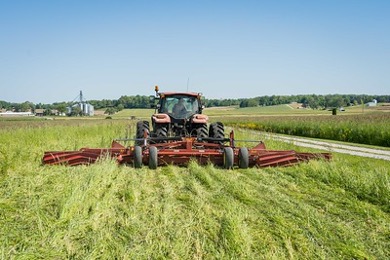The House and Senate are expected to approve a stopgap funding bill to keep the government open when the new fiscal year starts on Friday.
House Appropriations Committee Chairman Rosa DeLauro, D-Conn., confirmed to reporters Wednesday that the bill would include $30 billion in disaster aid, which should include assistance for farmers and ranchers.
The senior Republican on the Senate Ag Committee, Arkansas Sen. John Boozman, said the bill would also include an extension of authority for USDA’s livestock price reporting system.
USDA makes move on climate projects
USDA will be taking public comment for the next month on the Biden administration’s plan to fund large-scale projects aimed at helping farmers benefit from climate-based markets.
In a notice being published today in the Federal Register, USDA notes that consumers are showing a preference for commodities produced with climate-smart practices and that farmers also have an opportunity to start selling carbon offsets.
USDA poses a series of questions it wants responses to, including how the projects would affect existing offset markets.
Take note: USDA isn’t confirming that it will use its Commodity Credit Corp. spending authority to fund the projects. But the request for information was posted by CCC staff.
Boozman called for Senate Ag Committee hearings on the initiative, including the possible use of CCC funding. “It is our responsibility as a committee to conduct oversight on USDA’s efforts, and the questions that surround this initiative are a prime example of why that authority exists,” Boozman said.
On Wednesday, USDA announced that it was using CCC to provide $1.5 billion in assistance to agriculture for drought and supply chain disruptions and to prevent the spread of African swine fever. Another $1.5 billion is going to help schools with the impact of the COVID-19 pandemic.
ERS: Meatpacking played key role in COVID spread
USDA economists say there’s “strong evidence” that meatpacking plants were a major catalyst for COVID-19 outbreaks in rural America early in the pandemic. But a “working paper” by the Economic Research Service also says there is “suggestive evidence” that policies instituted after the initial outbreak helped reduce the spread of the disease.
Eight of the 10 rural counties with the highest rates of COVID-19 in May 2020 were “meatpacking-dependent,” meaning that more than 20% of employment is in meatpacking, the paper says. Meatpacking-dependent counties had nearly 10 times more cases in early May than other manufacturing-dependent counties, but that disparity disappeared later, ERS says.
Industry’s take: The North American Meat Institute says the conclusions mirror the industry’s own findings that plants were able to successfully protect their workers once more information and resources became available.
House panel to FDA: Protect baby food
A House subcommittee is calling on FDA to act quickly to revise or set limits on heavy metals in baby food. The panel made the recommendation in a report that claims most of the industry is using “flawed” testing methods that underestimate contamination of their products.
In April, after an earlier report was released with similar information, FDA announced a ”Closer to Zero” campaign to reduce heavy metals in baby food, but the subcommittee of the House Committee on Oversight and Reform said the agency’s timelines are “far too slow.”
FDA says in a statement that the agency is making “steady progress” on the issue. “While we understand that people may want rapid changes, it is crucial that measures to limit toxic elements in foods do not have unintended consequences — like limiting access to foods that have significant nutritional benefits by making them unavailable or unaffordable for many families,” FDA says.
Industry response: Gerber, a unit of Nestle, says it’s “committed to reducing the levels of heavy metals in our baby foods to the lowest levels possible” but that all of its foods “meet all applicable guidelines and limits set by the FDA.”
Child labor report finds most kids work in ag
Seven in 10 of child laborers worldwide work in agriculture, the Labor Department says in a new report. The department found that “for the first time in decades, global progress against child labor has stalled and reversed direction.”
Argentina, Colombia, Costa Rica, Ecuador, Mexico and Peru were the only countries to make “significant advancement” in addressing child labor abuses in 2020, says the report by the Bureau of International Labor Affairs. The number of child laborers increased from 152 million in 2016 to 160 million in 2020.
Most of those kids work on family farms and in family enterprises, so it’s “critical to understand and address family reliance on children’s labor in the absence of strong social protections and income support,” the report says.
Philippine pork imports seen dipping next year
Philippine pork imports expanded rapidly this year when the country raised quotas and cut tariffs as it wrangled with the spread of African swine fever, but those purchases are expected to drop off in 2022, according to USDA’s Foreign Agricultural Service.
The Philippines imported 308,361 metric tons of pork in the first seven months of this year, a nearly 300% jump from the same time period last year. But the increased tariff rate quota is expected to expire next year and tariffs will rise to previous levels, FAS says.
The Philippines is expected to import 375,000 tons of pork in 2022, which would still be much higher than the 167,000 tons imported in 2020.
He said it. “Limited.” - Senate Judiciary Committee Chairman Dick Durbin, when asked by a reporter what options Democrats now have for including immigration reform in their budget reconciliation bill. The Senate parliamentarian has again ruled that such a provision would violate reconciliation rules.
“People lead desperate lives for fear of a knock on the door and no future for the kids, and unfortunately we can't find the language … for the reconciliation (bill) that might help them,” the Illinois Democrat said.
Correction: The Colorado-based biofuels company Gevo expects to process 30 million bushels of corn annually in a South Dakota plant. The amount in Wednesday’s Daybreak was incorrect.
Questions? Tips? Comments? Email Philip Brasher at philip@agri-pulse.com





